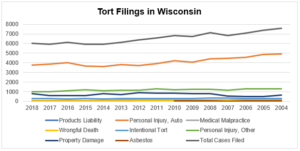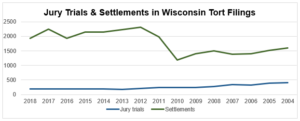Regulation of PFAS compounds is quickly moving forward in Wisconsin at both the legislative and administrative rule levels. PFAS (per- and polyfluoroalkyl substances) are man-made chemicals that are found in many everyday products, including nonstick pans, cleaning products, paints, and firefighting foam. PFAS are present in the bloodstream of 98 percent of Americans. Competing studies debate whether or not PFAS have negative health effects and, if they do, at what level they are harmful.
WCJC is part of the Water Quality Coalition, a coalition of industries, job creators, and taxpayers in the state, as well as scientists and legal scholars, which supports balanced, science-based environmental standards to regulate PFAS. Unnecessarily strict of standards would be costly to Wisconsin industry and would open up the state for frivolous lawsuits and potentially millions of dollars in liability.
Executive Actions
On August 23, Gov. Tony Evers signed Executive Order 40, which directs the state Department of Natural Resources (DNR) to coordinate with the Department of Health Services (DHS) and Department of Agriculture, Trade & Consumer Protection to:
- Establish a public information website.
- Collaborate with municipal wastewater treatment plants on screening to identify potential PFAS sources.
- Expand monitoring for PFAS in wildlife.
- Develop regulatory standards.
- Modify the Voluntary Party Liability Exemption law, “which provides future liability exemptions after successful completion of hazardous substance cleanup.”
- Assess opportunities for using natural resources damages claims under state or federal law.
- Create the PFAS Coordinating Council among state agencies. The council’s directions include developing an action plan, developing public education protocols, identifying sources, developing treatment protocols, collaborating with academic institutions on research, and exploring avenues for funding.
Agency Rulemaking
In June 2019, DHS recommended a groundwater standard of 20 parts per trillion (ppt) combined for PFOA and PFOS, the two most-studied types of PFAS. DHS also recommended a Preventive Action Limit (PAL) of 2 ppt. The PAL is the point at which DNR can begin working with a regulated entity to mitigate contamination before formal enforcement action. As part of the statutory process for developing groundwater standards in Wisconsin, DHS sends these recommendations to DNR, which then must promulgate administrative rules before the standard becomes enforceable.
WCJC, as part of the Water Quality Coalition, submitted a letter and comments to DHS regarding these strict recommendations. The comments noted DHS’s preventive action limit of 2 ppt for PFOA and PFOS combined could result in the most restrictive enforceable standard in the world, potentially greatly harming Wisconsin’s economy and significantly raising the cost of residential water. In particular, such a standard would require a permit holder, including municipal utilities, industrial facilities, and energy producers, to reach near-zero discharge levels of compounds that are pre-existing in groundwater.
DNR issued three scope statements related to PFAS earlier this month. Scope statements are the first step in the administrative rulemaking process. The scope statements would:
- Adopt groundwater standards. (SS 090-19). Under this scope statement, DNR would promulgate the DHS standards recommendations of 20 ppt combined for PFOA and PFOS and a 2 ppt PAL. This rule would apply to all regulated facilities that may impact groundwater.
Economic impact: DNR estimates a “moderate to significant” economic impact, ranging from $50,000 to greater than $5 million. However, other estimates of future business liability for PFAS have ranged in the billions.
Public hearings: DNR expects public hearings to occur in November 2020. - Adopt surface water quality standards for PFAS. (SS 091-19). Under the scope statement, DNR could also change Wisconsin Pollution Discharge Elimination System (WPDES) permit implementation procedures related to PFAS chemicals, including additional monitoring and new effluent limitations. Currently, DNR can address PFAS discharges in WPDES permits on a case-by-case basis. The proposed rule would set a uniform standard and procedures.
Economic impact: DNR anticipates the economic impact to “sources of PFOS and/or PFOA…to be significant,” citing costs associated with treatment technology.
Public hearings: DNR expects public hearings to occur in August 2021. - Adopt maximum contaminant levels (MCLs) for drinking water. (SS 089-19). MCLs for drinking water would mostly affect municipal water systems.
Economic impact: DNR estimates the economic impact of the rule to be “significant.” Treatment could cost municipal public water systems at least $25 million.
Public hearings: DNR expects public hearings to occur in August 2021.
If the scope statements become rules promulgated by DNR, they will be enforceable against regulated entities. In Wisconsin, rulemaking is a relatively lengthy process. DNR has stated they believe this rulemaking process will take about 30 months. The scope statements are the very first step in that process.
The DNR Board is set to approve the scope statements and an initial preliminary comment period at their meeting on Oct. 23.
Legislation
Rep. John Nygren (R-Marinette) & Sen. Rob Cowles (R-Green Bay) have introduced legislation (SB 310/AB 323) to address PFAS contamination from fire-fighting foams. The bill would prohibit the use of fire-fighting foams that contain intentionally added PFAS in training, unless the testing facility has appropriate containment and treatment measures (as determined by DNR rule).
The bill has mostly Republican cosponsors but also includes Rep. Melissa Sargent (D-Madison), whose district includes a well in Madison that has tested positive for PFAS. Other supporters of the bill include American Chemistry Council, American Petroleum Institute, Wisconsin Manufacturers & Commerce, Wisconsin Paper Council, and Wisconsin Rural Water Association. Several environmental advocacy groups have concerns that the bill does not go far enough to address PFAS contamination in Wisconsin.
The Senate Committee on Natural Resources & Energy and the Assembly Committee on Environment each held a public hearing on the bill on Sept. 3. At the hearing, DNR testified recommending changes to the bill to strengthen the state’s authority to prevent future PFAS discharges. The DNR recommendations included:
- Authorizing DNR to regulate more types of PFAS-containing foams.
- Requiring manufacturers to clearly label PFAS-containing foams.
- Requiring preventative and mitigative actions for entities using PFAS-containing foams in emergencies.
DNR noted that, in their opinion, the bill does not go far enough to address PFAS from other industries and noted that another bill currently introduced in the Legislature would address their concerns: SB 302/AB 321 by Sen. Mark Miller (D-Monona), Sen. Dave Hansen (D-Green Bay), Rep. Chris Taylor (D-Madison), Rep. Stausch Gruszynski (D-Green Bay) & Rep. Melissa Sargent (D-Madison). This bill has not yet received a hearing in the Legislature.
The Democrats’ bill would require DNR to establish and enforce PFAS standards by rule for drinking water, groundwater, surface water, air, solid waste, beds of navigable waters, and soil and sediment if DNR deems it harmful to human health or the environment. The bill also provides that DNR may require entities possessing PFAS to provide proof of financial responsibility for remediation of potential discharge. Additionally, the bill requires any facility under investigation by DNR to provide DNR with access to information related to transportation of hazardous waste to any other site. The bill provides 7.5 positions at DNR and 2 positions at DHS, plus $150,000 for identifying and prioritizing PFAS sources, $50,000 for a study on use of fire-fighting foam containing PFAS, $87,000 for testing landfills and leachate, and $120,000 for investigation of PFAS sources and providing drinking water.
Assembly Speaker Robin Vos (R-Rochester) has also convened a Speaker’s Task Force on Water Quality, which has discussed PFAS at several of their public hearings throughout the summer.
For more information on PFAS developments in Wisconsin, visit /pfas/.


